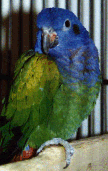
Blue Headed bred by Bruce & Alicia McWatters

Blue Headed bred by Bruce & Alicia McWatters
Special Thanks to C.T.E. Partridge for providing the information on this page.
The Blue-headed parrot is easy to identify. They are about 11 inches with a short tail
and stocky body. The entire body is green with the head and neck a bright blue. Some
adults do have a small area of pink feathers at the throat. Underneath the tail are the
typical red feathers found in all pionus species. The beak and feet of mature Blue-headed
parrots are black with a red area at the base of the upper mandible.
Immature Blue-headed parrots have several distinctive features. Until about one year of
age they have very little blue. The blue that they do have is just blue edging on green
feathers, and then only on the forehead. By one year of age they will have almost all of
their blue coloring. However, the blue can become slightly more extensive at their 2nd
year molt. Right above the cere (the nose holes) there will be a few red feathers. The
amount of red varies greatly between individuals. These red feathers fall out any time
between 3 months and one year of age. When first hatched, Blue-headed parrots have flesh
toned beaks. The upper mandible starts turning black first, then the lower mandible, and
then the red spot on the upper mandible starts to appear. The beak changes are usually
complete by 6 months of age, though the red may still get brighter over the first year.
There are two subspecies mentioned in Forshaw's book PARROTS OF THE WORLD, but I think
only one, P. m. rubrigularis is available in the U.S.A., and then only rarely. P. m.
rubrigularis is very similar to the common Blue-headed parrot except for a more extensive
area of pink at the throat and a slightly duller blue.
One unique feature of all pionus is a wheezing hissing sound they sometimes make when
they are frightened. Your first response might be to assume they are sick, as it sounds
similar to an asthma attack. However, if you back off the sound should stop. They can also
make a variation of this sound when being petted. Usually in this case it is a much softer
sound, closer to hissing. The other thing to be aware of is when you bring your pet to a
vet or bird groomer. If they are not familiar with pionus they might think the beak is
overgrown. It does look overgrown when compared to the beaks of some of the more common
parrots. Make sure you look at enough pictures so that you know what is right for your
bird. Remember that the fully adult bird will have a longer upper mandible than a baby.
28cm (11in), wing 18cm, weight 182-252g.
The average life span for a pionus is 25 years. However, there are many that live longer, some as old as 40. Remember, the main reason that birds die young is because of either accidents or bad nutrition! Don't let your pet become a statistic! Read as much as you can to make your home bird friendly and bird safe, clip those wings, and follow good nutritional practices.
As with all pionus species the Blue-headed parrot can not be visually sexed.
Both in Central and South America starting in Costa Rica and ending in central Brazil.
Seem to be good at training. They are surprisingly obedient birds that will learn simple tricks. As with any parrot *always* use the "up" and "down" commands. As long as your pionus understands the rules of the house and is raised in a very caring sensitiveway, with nurturing dominance, he will be a wonderful sweet pet. Remember, for your pionus to be wonderfully obedient he needs rules to follow. Practice those "up" and quot;down" commands with him and make sure he understands what acceptable behavior is. There are many good parrot training/behavior books out there. Make sure you take the time to read them.
Pionus are not know for their talking ability. If that is what you are looking for in a parrot, then keep looking. With pionus, talking is highly variable between Individuals. On average, they learn to say a few words (as in under 10), but don't say them with much clarity. Because of the high variability however, there are some individuals who speak quite clearly and learn 20 words.
Compared to any of the larger parrots a pionus will always rate as quiet. Pionus also tend to be much quieter than most conures. However, even though pionus are rated as quiet birds, they can learn to screech, and can be louder than some cockatiels. Most pionus screaming is because of their environment and the way they are raised. A happy pionus does not have to be a screaming pionus. Then again, a pionus that screams is not necessarily unhappy.
$500-$1,000. This large range is due to regional variation and whether you buy from a breeder or pet shop. Please remember that a cheaper bird is not a better bird.
|
Updated : 10/2022
(c) 1994-2022 Grant Yoshimori